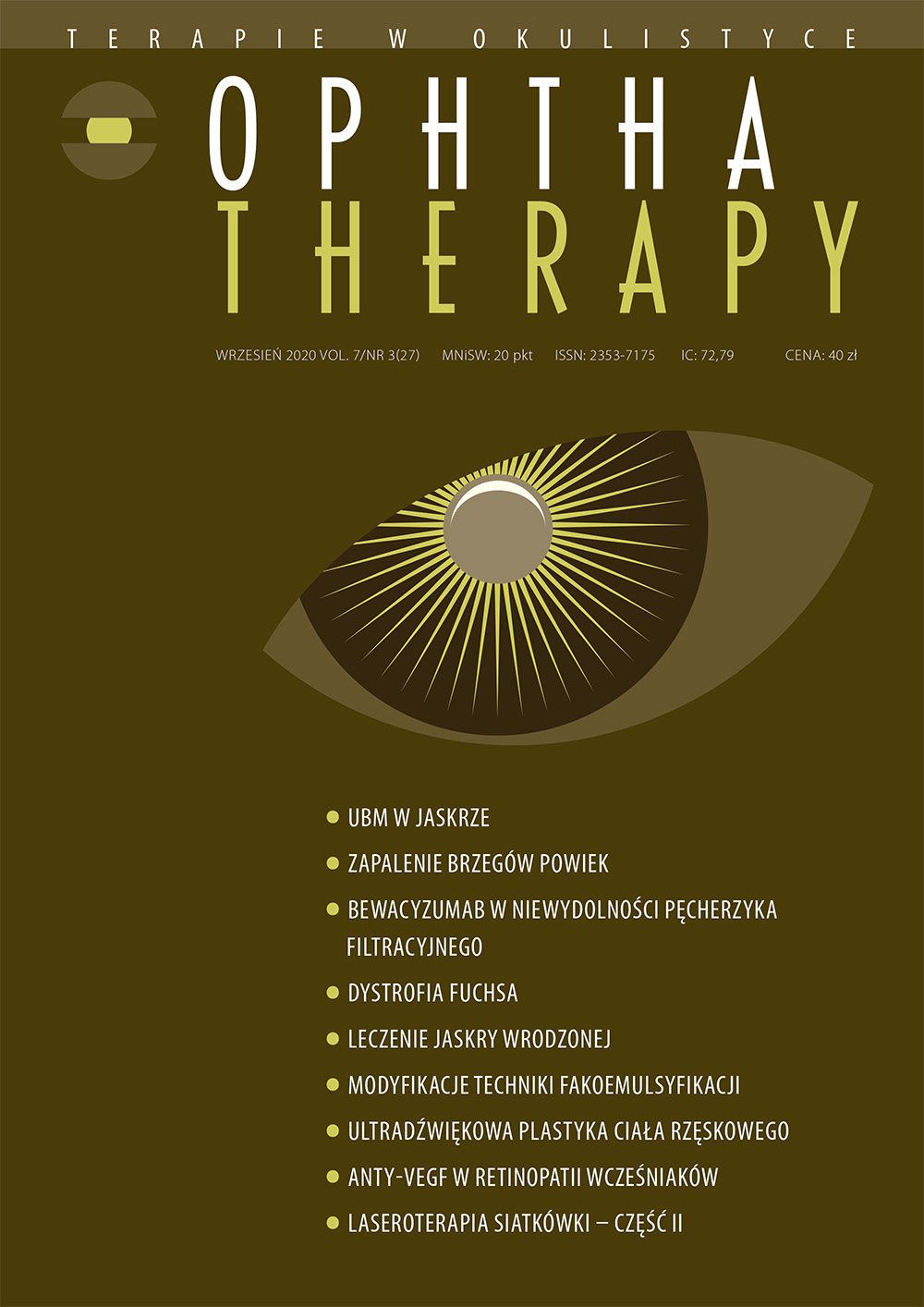Badanie UBM w diagnostyce, leczeniu i prowadzeniu pacjentów z jaskrą Artykuł przeglądowy
##plugins.themes.bootstrap3.article.main##
Abstrakt
Badanie ultrabiomikroskopowe to silne narzędzie diagnostyczne, które może pomóc w prowadzeniu i leczeniu wielu pacjentów. Jest szczególnie pomocne w przypadku jaskry, gdyż nie zawsze patomechanizm powstawania zmian jest znany, a uszkodzenie nerwu wzrokowego często postępuje. Będąc świadomym przyczyny, można skutecznie leczyć pacjenta. Samo badanie UBM nie może jednak zastąpić pełnego badania klinicznego, włącznie z wykonaniem gonioskopii dynamicznej. Jest ono świetnym uzupełnieniem, które może potwierdzić wiele postawionych diagnoz.
Pobrania
##plugins.themes.bootstrap3.article.details##

Utwór dostępny jest na licencji Creative Commons Uznanie autorstwa – Użycie niekomercyjne – Bez utworów zależnych 4.0 Międzynarodowe.
Copyright: © Medical Education sp. z o.o. License allowing third parties to copy and redistribute the material in any medium or format and to remix, transform, and build upon the material, provided the original work is properly cited and states its license.
Address reprint requests to: Medical Education, Marcin Kuźma (marcin.kuzma@mededu.pl)
Bibliografia
2. Dietlein T, Engels B, Jacobi P et al. UBM-guided chamber angle surgery for glaucoma management: an experimental study. Eye. 2003; 17: 340-5.
3. Higgitt AC. The dark-room test. Br J of Ophthalmol. 1954; 38: 242-7.
4. Wang N, Lai M, Cheng X et al. Ultrasound biomicroscopic dark room provocative test. Zhonghua Yan Ke Za Zhi. 1998; 34(3): 183-6, 12.
5. Dada T, Kumar G, Kumar Mishra S. Ultrasound Biomicroscopy in Glaucoma: An Update. J Curr Glaucoma Pract. 2008; 2(3): 17-32.
6. Dada T, Gupta V, Deepak KK et al. Narrowing of the anterior chamber angle during Valsalva maneuver: A possible mechanism for angle closure. Eur J Ophthalmol. 2006; 16: 81-91.
7. Kosmala J, Grabska-Liberek I. Ultrabiomikroskopia – zastosowanie w okulistyce. Termedia, Poznań 2014.
8. Méndez-Hernández C, Garcia-Feijoo J, Cuina-Sardina R. Ultrasound biomicroscopy in pigmentary glaucoma. Arch Soc Esp Oftalmol. 2003; 78(3): 137-42.
9. Pillunat L, Bohm A, Fuisting B. Ultrasound biomicroscopyin pigmentary glaucoma. Ophthalmologe. 2000; 97: 268-71.
10. Rockwood E, Sharma S, Hayden B et al. Glaucoma. In: Singh A, Hayden B, Pavlin C (ed). Ultrasound Clinics. Elsevier Inc, USA, Canada 2008: 207-15.
11. Wei W, Yang W, Chen Z et al. A study on ocular anterior segment structure after scleral buckling surgery for retinal detachment. Zhonghua Yan Ke Za Zhi. 1999; 35(4): 309-11, 317.
12. Fleck B, How large must an iridotomy be? Br J Ophthalmol. 1990; 74: 583-8.
13. Dada T, Mohan S, Sihota R et al. Comparison of ultrasound biomicroscopic parameters after laser iridotomy in eyes with primary angle closure and primary angle closure glaucoma. Eye. 2007; 21: 956-61.
14. Kumar G. Prevalence of plateau iris in primary angle closure suspects, a UBM study. Ophthalmology. 2008; 115: 430-4.
15. Garudadri C, Chelerkar V, Nutheti R. An ultrasound biomicroscopic study of the anterior segment in Indian eyes with primary angle-closure glaucoma. J Glaucoma. 2002; 1: 502-7.
16. Marigo F, Finger P. Anterior segment tumors: current concepts and innovations. Surv Ophthalmol. 2003; 48: 569-93.
17. Avitabile T, Russo V, Uva M et al. Ultrasound-biomicroscopic evaluation of filteringblebs after laser suture lysis trabeculectomy. Ophthalmologica. 1998; 212: 117-21.
18. Wu Q, Zhang Y, Song B et al Evaluation of the bleb morphology and the function of postfiltration surgery using slit-lamp adapted optical coherence tomography and ultrasound biomicroscopy in glaucoma patients. Zhonghua Yan Ke Za Zhi. 2008; 44: 402-7.
19. Mansouri K, Sommerhalder J, Shaarawy T. Prospective comparison of ultrasound biomicroscopy and anterior segment optical coherence tomography for evaluation of anterior chamber dimensions in European eyes with primary angle closure. Eye. 2010; 24(2): 233-9.

